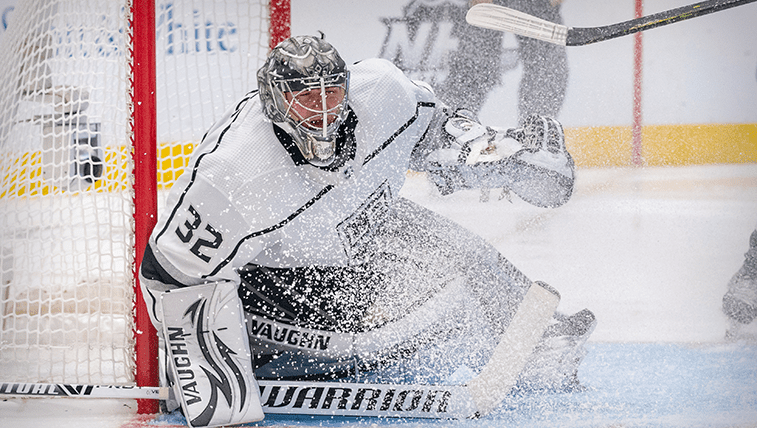McKenna: What’s wrong with Jonathan Quick?

Why has Jonathan Quick been outplayed by his goalie partners over the past four seasons?
Simply put: his game hasn’t evolved. Where other goalies have modernized with technical changes, Quick has largely been steady in his approach for the better part of the past decade.
This past week I received a question for McKenna’s Mailbag asking about several recent goals he allowed..
Loved your column last week and thanks again for answering my? My #askmckenna relates to Jonathan Quick giving up 2 crucial goals this week over the blocker while paddled down - can you see a situation where a goalie should still use that? Maybe wrap around?
It’s a great observation. On both goals, Quick’s decision to use paddle-down ends up costing him. It’s one of the biggest problems with his game: overreliance on a technique that is rarely necessary in today’s game.
And there’s no hiding it. Teams are aware of Quick’s tendency and it’s being exposed. Six of the thirteen goals that he’s allowed so far this season involved paddle-down.
On both goals, Quick starts the play in position. His torso is upright and he’s filling plenty of net. But as Denis Gurianov and Vladimir Tarasenko move closer, Quick becomes impatient and defaults to putting the paddle of his stick flat on the ice.
In doing so, he opens up a ton of net on his blocker side. Both goals go past Quick in space that he once occupied.
There are still instances where paddle-down makes sense. It works on wraparounds to the blocker side. It can also be used effectively to cut off passes. But goalies get into trouble when they use it outside of those parameters.
In general, paddle-down leads to a goaltender abandoning space, getting wide, playing small, and unable to rotate.
This goal by Pierre-Luc Dubois is a great example of a situation where Quick’s paddle-down tendency prevents him from being able to rotate and push to the far post. After the initial shot by Kyle Connor, Quick reacts to the rebound by settling into paddle-down with his right skate against the post.
Look at the angle of Quick’s right leg. It’s perpendicular to the goal line. And because of paddle-down, all of his weight is forward in front of the post. Put these ingredients together and it locks Quick into place. He’s unable to rotate back to the goal line. All he can do is reach. And that’s not enough to prevent Dubois from scoring on the wraparound.
Flip back to Oct.r 16 when Quick and the LA Kings lost 3-2 at home to the Minnesota Wild. At some point leading up to all three goals against, Quick goes paddle-down.
Goal 1: When the puck goes behind the net, Quick instinctively reaches and goes paddle-down to the far post. Then he recovers to his edges only to go paddle-down once again for reasons unknown. Maybe he’s nervous that Kevin Fiala is going to sling the puck to the net along the ice. But by going paddle-down, Quick exposes the entire far side of the net. And it also prevents him from rotating to the middle of the crease. He can only attack forward at a diagonal towards Wild forward Frederick Gaudreau. The end result is Gaudreau scoring into a half-open net.
Goal 2: As Kirill Kaprizov approaches the net, Quick becomes impatient and elects to use a preventative vertical/horizontal (VH) posture in front of his post in conjunction with paddle-down. Kaprizov dishes the puck to Victor Rask in the slot and Quick is forced to react laterally. But he’s late on the play and unable to get square to Rask’s shot because he was locked into paddle-down before the pass. His weight was on his blocker hand – on the ice. Quick is so off-balance that he’s unable to react in time.
Goal 3: Quick gets in trouble when he unnecessarily goes paddle-down against Marcus Foligno in the slot. Not only does he make himself smaller and expose more net to Foligno, he also makes it incredibly difficult to move efficiently to his blocker side. Once again Quick is forced to reach to the far post. Had he kept his torso vertical, Quick would have been able to play within the posts and push his entire body over. Instead, his weight is so far forward that all he can do is fall on his belly and try to get a blocker on Ryan Hartman’s shot.
All three goals are the result of poor defense and players being alone in front of the Kings net. But that does not absolve Quick of blame. I’m not saying he saves all three shots if he doesn’t go paddle-down. But he certainly would have had a better chance.
Quick is one of the best goaltenders of his era. And with two Stanley Cups to his name, a strong candidate for the Hockey Hall of Fame. But his lack of technical adaptation is troubling and it’s directly reflected in his statistics.
Quick’s game has barely evolved since he hoisted the Stanley Cup alongside his Kings teammates in 2014. He’s one of the most athletic and competitive goaltenders in the world. Players hold him in high regard. But without technical adaptation – including limiting the use of paddle-down – it’s hard to envision Quick rising to the top of the league once again.
More from Mike McKenna
- Ranking every NHL goalie tandem for 2023-24
- Staring down Lou: How standing up for yourself can change a player’s career
- Why it’s time to embrace ‘gambles’ like the Jake Sanderson contract
- Why we shouldn’t view Sheldon Keefe’s contract extension as a vote of confidence
- ‘Two Sean O’Connors?’ NHL training camps bring the funny – and the weird